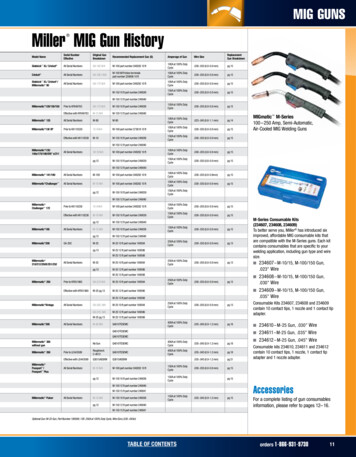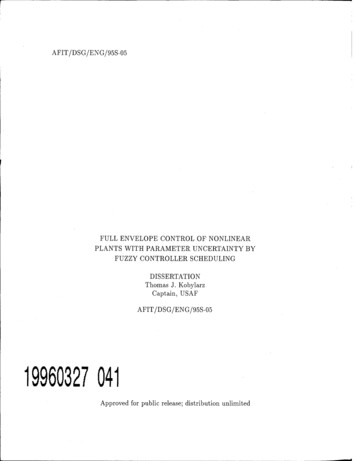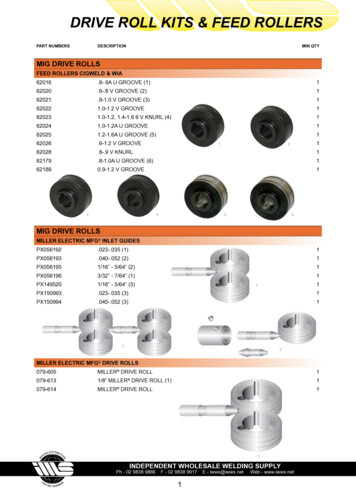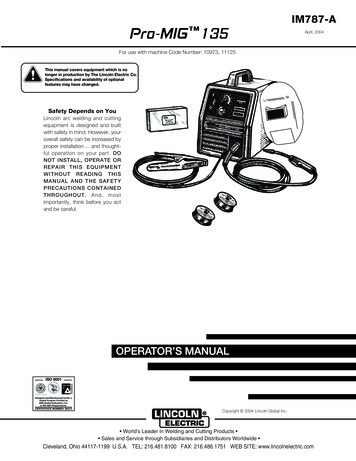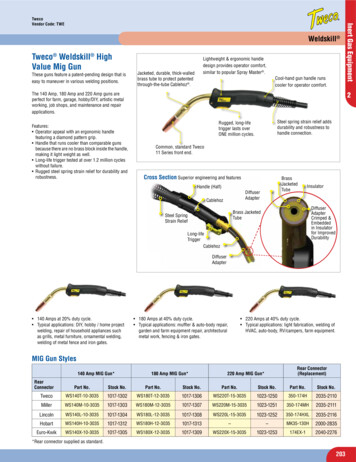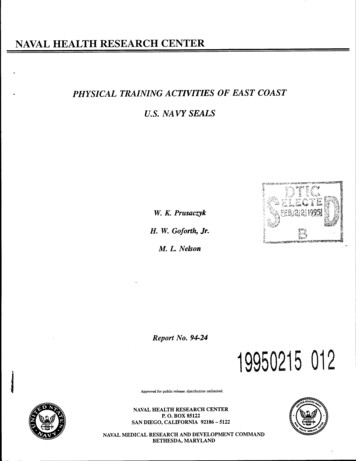
Transcription
NAVAL HEALTH RESEARCH CENTERPHYSICAL TRAINING ACTIVITIES OF EAST COASTU.S. NAVY SEALSfei- i , i * * J Iyv I!.:? '"', "" a «i i« ** A * # \jjj IW. K. PrusaczykH. W. Goforth, Jr.'.- . .»lu j feu l ** #.Jäiy»h,-' I- M. L. NelsonReport No. 94-2419950215 012Approved for public release: distribution unlimited.NAVAL HEALTH RESEARCH CENTERP. O. BOX 85122SAN DIEGO, CALIFORNIA 92186 - 5122NAVAL MEDICAL RESEARCH AND DEVELOPMENT COMMANDBETHESDA, MARYLAND
Physical Training Activities of East CoastU.S. Navy SEALsW. K. Prusaczyk, Ph.D.H. W. Goforth, Jr., Ph.D.M. L. Nelson, M.S.Naval Health Research CenterP.O. Box 85122San Diego, California 92186-5122!Report No. 94-24, supported by the Navy Medical Research and Development Command,Department of the Navy, Bethesda, Maryland under work unit 62233N MM33P30.002-6005.The views expressed in this paper are those of the authors and do not reflect the officialpolicy or position of the Department of the Navy, the Department of Defense, or the U.S.Government. Approved for public release; distribution is unlimited.
SUMMARYProblem.U.S. Navy Sea-Air-Land (SEAL) personnel often conduct physically demanding missionsunder highly stressful conditions. The missions, conducted in both terrestrial and maritimeenvironments, frequently require high levels of both aerobic (muscular and cardiorespiratoryendurance) and anaerobic (muscular strength and power) fitness. SEALs must maintain fitnesswhile undergoing extensive operational training that may limit the availability of physical trainingtime.Objective.This survey was conducted to document, the aerobic, strength, and overall conditioningprograms of Navy SEALs on the East Coast and to serve as a baseline for future studiesevaluating the effectiveness of self-selected training programs in maintaining physical fitness.A study on SEALs assigned to West Coast commands has been reported previously byPrusaczyk, Go forth, and Nelson (1990).Approach.A detailed physical training activity questionnaire was administered to 75 East Coast U.S.Navy Sea-Air-Land (SEAL) personnel undergoing advanced training. Questions were designedto document the mode (type), duration, frequency, and intensity of exercise and thelocations/facilities where the SEALs engaged in regular physical fitness training. The trainingactivities were evaluated according to the American College of Sports Medicine guidelines fordeveloping and maintaining aerobic and strength fitness.Results.Overall, these East Coast SEALs reported engaging in aerobic activities (running,swimming, bicycling) at frequencies, intensities, and durations adequate for maintaining aerobicfitness levels. Strength conditioning was also determined to be of sufficient volume to maintaincurrent levels of muscular strength.II l I——gfnU
Conclusions.Although East Coast SEALs engage in physical training activities with sufficient volumeand intensity to maintain current levels of physical fitness, there is evidence that SEALs cansignificantly improve both aerobic and anaerobic fitness with only 90 additional minutes oftraining per week (Jacobs, Prusaczyk, & Goforth, 1994). The effectiveness of the current trainingprograms should be evaluated to ensure SEALs' ability to meet the most physically demandingtasks they may be required to perform (Stuster, Goforth, Prusaczyk & Meyer, 1994).Additionally, these data will serve as baseline data in other studies evaluating physical trainingprograms for SEALs and to assist in the development of guidelines for avoiding detraining underconditions where appropriate equipment and training opportunities are limited (e.g., shipboardand submarine deployments).
INTRODUCTIONU.S. Navy Sea-Air-Land (SEAL) personnel often conduct physically demanding missionsunder highly stressful conditions (Stuster, Goforth, Prusaczyk, & Meyer, 1994). The missions,conducted in terrestrial and maritime environments, frequently require high levels of both aerobic(muscular and cardiorespiratory endurance) and anaerobic (muscular strength and power) fitness.In fact, it has been suggested that SEALs rely on their physical fitness more than any other U.S.military component (Barnes & Strauss, 1986).Because of the physical demands of theirmissions, SEALs are required to maintain higher fitness standards than other Navy personnel(BUPERS Manual 1410-380).Physical fitness levels and anthropometric profiles of SEALs and Basic UnderwaterDemolition/SEAL (BUD/S) students have been documented previously (Beckett, Goforth, &Hodgdon, 1989). These data showed that BUD/S students and platoon SEALs have relativelyhigh aerobic fitness, with mean peak oxygen uptakes (V02peak) of 62.4 ml'kg min'1 and 57.7ml kg' min"1, respectively. SEALs also have a high mesomorphic (i.e., muscularity) component(5.8 0.9) on the Heath-Carter somatotype scale (Carter, 1980). Interestingly, mesomorphyscores for BUD/S students graduating in 1989 (5.8 0.8; Beckett et al., 1989) were not differentfrom those graduating in 1973 (5.9 1.5; Carter & Rahe, 1973).Maximal aerobic power, measured as V02peak, is a laboratory measure used to evaluatemaximal energy output by aerobic processes (Ästrand & Rodahl, 1977) and is an indicator of theability to perform endurance activities. While it has been suggested that U.S. Army SpecialForces (SF) soldiers have the highest aerobic power of any U.S. military population (Muza, etal., 1987), Beckett and colleagues (1989) documented a mean V02peak for SEALs that was morethan 6% higher than Army SF personnel. Although the VOZpeak of these platoon SEALs washigher than the Army SF, it was significantly lower (8%) than recent BUD/S graduates. Thedecrement in V02peak cannot be ascribed solely to the age difference (22 2 yr for BUD/S and26 4 yr for SEALs). Instead, the decrease may reflect reduced physical training volume orintensity and a shift toward increased operational readiness training.To maintain the levels of aerobic and anaerobic fitness required for full mission capability,SEALs perform regular physical training with their platoons or detachments. In addition, most
SEALs engage in other physical training activities (Barnes & Strauss, 1986). These activitiesinclude individual physical training, skilled activities, and team sports. Analysis of SEALs'physical training activities could provide basic information on the effectiveness of the overalltraining program for maintaining mission-related fitness. The mission of SEALs on the twocoasts is often viewed as somewhat different (Stuster, Goforth, & Prusaczyk, 1993; Stuster, etal., 1994); therefore, documentation of the physical training activities of SEALs from the twocoasts was undertaken. Data on the physical training activities of SEALs from West Coastcommands (SEAL Teams One, Three, and Five and SDV Team One) has been reportedpreviously by Prusaczyk, Goforth, and Nelson (1990). This survey was conducted to documentthe aerobic and strength conditioning programs of East Coast U.S. Navy SEALs and to evaluatethe effectiveness of the self-selected training programs in maintaining physical fitness.MATERIALS AND METHODSPhysical activity questionnaires (Appendix A) were distributed to East Coast SEALsundergoing advanced operational training.The SEALs were involved with one of elevendifferent courses or activities: 1) Combat Swimmer, 2) Land Warfare, 3) Maritime Operations,4) Cold Weather Training, 5) Classroom Preparation, 6) Stand-Down Preparation, 7) MissionPreparation, 8) Exercises, 9) Field Activities, 10) Core Training, or 11) Advanced SDV Training.The questionnaires were used to collect data on the characteristics of SEALs' physical trainingactivities, including the type of fitness activities (i.e., aerobic, anaerobic, skill/sport, etc.);frequency, duration, and intensity of participation; and the locations and conditions of training.Descriptive statistics were computed for each question using SPSS-X Release 3.1 for VAX/VMSon the Naval Health Research Center's VAX 6000, Model 310 computer.
RESULTSPhysical Training Activities.A total of 75 questionnaires were completed and returned from the East Coast SEALs.The data in the tables below are based on the responses provided by the SEALs. The statisticsare based on the total number of individuals responding on each question. The number of SEALsengaging in individual physical conditioning activities and the mean frequencies with which theyengaged in the activities are presented in Table 1.Table 1.Frequency of participation (times per week) in fitness activities during .2Calisthenics68914.01.4Obstacle Course67891.61.2SCUBA/Snorkel65871.41.1Weight 82.7Rowing16211.81.68112.82.0ACTIVITY Aerobics ClassLegend: ACTIVITY is the type of exercise in which SEALs engaged.N is the number of SEALs engaging in the activity.% N is the percent of 75 SEALs who reported engaging in the activity.MEAN is the arithmetic mean of the responses.SD is the standard deviation about the mean.The number of SEALs reporting participation in skill or team sport activities and thefrequency with which they participated are summarized in Table 2.
Table 2. Frequency of participation (times per week) in skill, team, and other activitiesduring advanced et .6Basketball21282.21.8Football19251.41.4Martial herLegend for Table 2 is the same as for Table 1. [The data presented reflect the meanresponses of those providing the information.]The characteristics of running, the most frequently employed method of aerobic training,are summarized in Table 3. This table outlines frequency, duration, volume, and intensity ofrunning. To determine total running time per week, the product of frequency (4.1 times perweek) and duration (46.1 min per run) was calculated. The mean frequency-duration product was189 minutes of running per week.Only 17% of SEAL respondents reported running while carrying a load (e.g., backpack),while 20% reported load carriage while walking. The mean ( SD) pace in minutes per mile was9.9 min ( 1.2 min) for running and 17.4 min ( 12.7 min) for walking.
Table 3. Characteristics of running as a physical training activity among East Coast SEALs.N%NMEANSDFrequency (times per week)38514.11.0Duration(minutes per run)385146.126.3Intensity (minutes per mile)39537.50.7Volume375020.58.3ATTRIBUTE(miles per week)Legend: ATTRIBUTE is the characteristic of running described.N is the total number of SEALs reporting on the attribute.% N is the percent of SEALs reporting on the attribute as a percent of those reportingengaging in the activity (Table 1).MEAN is the arithmetic mean of responses for the attribute.SD is the standard deviation about the mean.Table 4 summarizes the frequency with which SEALs train on various surfaces (running),locations and equipment used for aquatic activities (swim/scuba/snorkel), and equipment used(bicycle and rowing machines). Table 5 summarizes the frequency with which SEALs usevarious training surfaces for skill and team sport activities.8
Table 4. Frequency of use (times per week) of various physical training surfaces, locations, andequipment for aerobic 6Ocean64981.30.8with Fins62971.41.0without Fins17271.40.8Pool51711.51.0Ocean68941.30.6with Fins64891.40.9without wimmingBicyclingRowingLegend for Table 4 is the same as for Table 1.
Table 5. Frequency of use (times per week) of physical training surfaces for skill and teamsport ACERacquet Sports/HandballWoodBasketballVolleyballLegend for Table 5 is the same as for Table 1 with the addition of surface upon which theactivity was performed.Eighty-three percent of the SEALs reported engaging in weight training as an activity.Overall, weight training focused on upper body exercises. Detailed descriptions of the numberof sets performed, number of repetitions per set, weights used, duration of exercise, perceivedeffort, and the one-repetition maximal (1-RM) weight lifted are presented in Table 6. Weighttraining sessions lasted an average of 59 15 minutes (Table 7).Tables 7 and 8 summarize the mean frequency, duration, and perceived intensity ofSEALs' participation in each of the individual physical training activities and in the skill andteam sports, respectively.10
Table 6. Characteristics of East Coast SEALs' weight training exercise.Number of SetsEXERCISEMEANNSDRANGE*UPPER BODY EXERCISESNeck163.41.71-9Upright Rowing273.71.51-9Bent Rowing234.01.61-9Bench Press434.51.81-9Military Press324.01.41-9Incline Press354.21.71-9Biceps Curl434.21.91-9Triceps Curl394.01.71-9Latissimus Pull164.11.61-9Wrist Curl193.81.21-6Sit-up154.12.12-9LOWER BODY EXERCISESLeg Press151.10.51-3Squat153.91.41-6Leg Curl163.31.31-6Toe Raises163.51.31-9Leg Extension153.41.11-643.30.53-42.33-9Stair ClimbOTHER EXERCISESOther5.25''Range is range of response values reported.11
Table 6. Characteristics of East Coast SEALs' weight training exercise (continued).Repetitions per SetEXERCISEMEANNSDRANGEUPPER BODY EXERCISESNeck1511.66.53-30Upright Rowing2710.01.94-13Bent Rowing2310.21.36-13Bench Press4310.02.71-20Military Press3210.11.74-13Incline Press359.81.74-13Biceps Curl4310.72.94-20Triceps Curl4010.62.64-20Latissimus Pull3510.42.84-20Wrist Curl1912.44.99-30Sit-up1337.531.710-99LOWER BODY EXERCISESLeg Press1511.75.110-30Squat157.31.85-10Leg Curl1710.92.510-20Toe Raises1515.27.110-30Leg Extension1510.50.910-13513.66.410-254.78-20Stair ClimbOTHER EXERCISESOther11.8512
Table 6. Characteristics of East Coast SEALs' weight training exercise (continued).Duration (minutes)*EXERCISEMEANNSDRANGEUPPER BODY EXERCISESNeck1013.316.91-60Upright Rowing2115.920.61-90Bent Rowing1618.923.01-90Bench Press3016.817.61-90Military Press2416.219.21-90Incline Press2516.618.71-90Biceps Curl2915.918.01-90Triceps Curl2815.318.01-90Latissimus Pull2515.826.91-90Wrist Curl1319.625.81-90815.412.65-45Sit-upLOWER BODY EXERCISESLeg Press1121.128.01-90Squat1222.526.51-90Leg Curl1219.827.11-90Toe Raises1415.122.31-90Leg Extension1220.026.91-9025.00.05-53.05-12Stair ClimbOTHER EXERCISESOtherDuration (minutes):8.65O-(none); 1-( 11); 2-(ll-20); 3-(21-30); 4-(31-40); 5-(41-50); 6(51-60); 7-((61-119); 8-(120-180); 9-( 180)13
Table 6. Characteristics of East Coast SEALs' weight training exercise (continued).Weight used (pounds)EXERCISE* iMEANNSDRANGEUPPER BODY EXERCISESNeck1033.022.15-90Upright Rowing2589.038.320-180Bent Rowing20122.157.125-190Bench Press40184.646.0100-280Military Press28112.838.430-180Incline Press31131.343.850-225Biceps Curl3964.523.025-110Triceps Curl3562.330.015-170Latissimus Pull31144.553.850-220Wrist Curl1548.324.715-100553.085.210-205Sit-upLOWER BODY EXERCISESLeg Press12123.853.840-200Squat13203.382.880-350Leg Curl1474.631.240-150Toe Raises11134.167.210-220Leg 0Stair ClimbOTHER EXERCISESOther103.8414
Table 6. Characteristics of East Coast SEALs' weight training exercise (continued).One-repetition maximum (pounds)EXERCISEMEANNSDRANGEUPPER BODY EXERCISES63518.75- 60Upright Rowing1812853.835-245Bent Rowing1315364.935-225Bench Press2824366.210-365Military Press2115447.290-285Incline Press2317561.665-275Biceps Curl268840.520-180Triceps Curl267940.815-190Latissimus Pull2116449.515-250Wrist Curl96739.920-130Sit-up46937.525-100NeckLOWER BODY EXERCISESLeg Press8351123.9200-500Squat928391.2160-400Leg Curl810447.840-180Toe Raises5201118.740-375Leg Extension816645.065-200Stair Climb159——35.415- 65OTHER EXERCISESOther24015v. i
Table 6. Characteristics of East Coast SEALs' weight training exercise (continued).Perceived Effort*EXERCISEMEANNSDRANGEUPPER BODY EXERCISESNeck145.71.84-10Upright Rowing277.21.84-10Bent Rowing226.71.94-10Bench Press437.21.93-10Military Press327.31.64-10Incline Press357.41.74-10Biceps Curl427.31.93-10Triceps Curl397.41.83-10Latissimus Pull367.21.95-10Wrist Curl217.11.94-10Sit-up147.32.24-10LOWER BODY EXERCISESLeg Press156.71.55-10Squat157.31.95-10Leg Curl176.82.04-10Toe Raises156.71.94-10Leg Extension176.91.95-1026.52.15-82.04-10Stair ClimbOTHER EXERCISESOther* Perceived intensity scale:6.861-very easy; 2-easy; 3-; 4-moderately difficult; 5-;6-difficult; 7-; 8-intense; 9-; 10-very intense16
Table 7. Summary of the characteristics of physical training activities of East Coast SEALsordered by number of ion on65875.61.9RunningSwimmingCalisthenicsObstacle CourseSCUBA/SnorkelScales keyFrequency:Intensity:Duration (minutes):O-(never); l-( 0 & s lx/wk); 2-(2x/wk); 3-(3x/wk); 4-(4x/wk); 5(5x/wk); 6-(6x/wk); 7-(* 7x/wk)1-very easy; 2-easy; 3-; 4-moderately difficult -; 6-difficult; 7-; 8intense; 9-; 10-very intense0-(N/A); l-( 11); 2-(ll-20); 3-(21-30); 4-(31-40); 5-(41-50); 6-(51-60);7-((61-119); 8-(120-180); 9-( 180)17
Table 7. Summary of the characteristics of physical training activities of East Coast SEALsordered by number of participants .61.9ATTRIBUTEWeight TrainingBicyclingWalkingRowingAerobics ClassScales KeyFrequency:Intensity:Duration (minutes):O-(never); l-( 0 & * lx/wk); 2-(2x/wk); 3-(3x/wk); 4-(4x/wk); 5(5x/wk); 6-(6x/wk); 7-(* 7x/wk)1-very easy; 2-easy; 3-; 4-moderately difficult -; 6-difficult; 7-; 8intense; 9-; 10-very intense0-(N/A); l-( 11); 2-(ll-20); 3-(21-30); 4-(31-40); 5-(41-50); 6-(5160); 7-((61-119); 8-(120-180); 9-( 180)18
Table 8. Summary of the characteristics of skilled/sport activities of East Coast SEALsordered by frequency of .7Duration15205.41.9VolleyballRacquet Sport/HandballBaseball/SoftballFootballMartial ArtsScales KeyFrequency:Intensity:Duration (minutes):O-(never); l-( 0 & s lx/wk); 2-(2x/wk); 3-(3x/wk); 4-(4x/wk); 5(5x/wk); 6-(6x/wk); 7-(* 7x/wk)1-very easy; 2-easy; 3-; 4-moderately difficult;5-; 6-difficult; 7-; 8intense; 9-; 10-very intense0-(N/A); l-( 11); 2-(ll-20); 3-(21-30); 4-(31-40); 5-(41-50); 6-(5160); 7-((61-119); 8-(120-180); 9-( 180)19
Table 8. Summary of the characteristics of skilled/sport activities of East Coast SEALsordered by frequency of participation equencyOther Skilled ActivityScales KeyFrequency:Intensity:Duration (minutes):O-(never); l-( 0 & lx/wk); 2-(2x/wk); 3-(3x/wk); 4-(4x/wk); 5(5x/wk); 6-(6x/wk); 7-(* 7x/wk)1-very easy; 2-easy; 3-; 4-moderately difficult -; 6-difficult; 7-; 8intense; 9-; 10-very intense0-(N/A); l-( 11); 2-(ll-20); 3-(21-30); 4-(31-40); 5-(41-50); 6-(5160); 7-((61-119); 8-(120-180); 9-( 180)DISCUSSIONThis report focused on physical training programs of East Coast SEALs. The principalaerobic and strength conditioning practices were documented by a questionnaire completed bySEALs. These data supplement information collected on physical profiles of BUD/S students andplatoon SEALs (Beckett, et al., 1989), and on physical training activities of West Coast SEALs(Prusaczyk, et al., 1990). Additionally, a report by Stuster, et al. (1994) provides valuableinformation on the physically demanding tasks and missions SEALs may be required to perform.The American College of Sports Medicine (ACSM) has published guidelines for thedevelopment and maintenance of cardiorespiratory (aerobic) and muscular (strength) fitness inhealthy adults (American College of Sports Medicine, 1990). Unfortunately, these guidelines arebased on average populations of Americans and may not be entirely applicable to very fit or elite20
military populations, like SEALs. Both the high V02peak reported for platoon SEALs (Beckett,et al., 1989) and the results of this survey suggest that SEALs are able to maintain goodcardiorespiratory fitness, despite the 8% average lower V02peak compared to BUD/S students.The ACSM guidelines suggest that to maintain aerobic fitness, exercise that involves repetitivecontraction of large muscle masses (i.e., legs, arms, or both) should be performed at least threetimes per week, for twenty to thirty minutes per session, and at an intensity of at least 60% ofV02peak. On average, the SEALs in this study reported engaging in physical training activitiesthat exceeded the levels required for maintenance of aerobic fitness.The mean values offrequency and duration reported in this survey were 4.1 times per week and 46 13 minutes persession.Based on the mean minute-per-mile pace reported, mean V02 during running(calculated for the average SEAL body weight of 175 lbs) would be 80% of the V02peakpreviously reported for platoon SEALs (Beckett et al., 1989). While this is slightly lower thanthe 85% V02peak reported for West Coast SEALs (Prusaczyk, et al., 1990), both intensities arewell above the ACSM guidelines for maintenance of cardiorespiratory fitness.Recent work by Jacobs, et al. (1994) demonstrated that SEALs can increase indicators ofaerobic fitness and anaerobic capacity in as little as three weeks, training 30 minutes per day,three times per week. These data suggest that although SEALs report performing regular aerobicexercise surpassing ACSM guidelines, they could, with an effective training program, increaseaerobic fitness. It has been reported that the quantity of aerobic activity is often perceived to behigher than it actually is, especially for very active individuals (Klesges, Eck, Mellon, Fulliton,Somes, & Hanson 1990). In this regard, it is possible that the exercise reported here may besomewhat higher than the actual exercise in which they regularly engage. However, based onthe previous reports of SEALs' V02peak (Beckett, et al., 1989), it appears that SEALs maintainrelatively high levels of aerobic fitness.Limited scientific data are available on conditioning activities required to maintainmuscular strength in fit individuals. However, it appears that even when training is discontinuedor dramatically reduced, strength declines at a much slower rate than the rate at which it wasgained (Fleck & Kramer, 1987). Further research is required to determine the exact loading,frequency, and type of program (e.g., sets and repetitions per set) needed to maintain individualspecific training gains in muscular strength. ACSM guidelines propose training at least two days21
per week with 8 to 12 repetitions of each exercise per session to maintain muscular strength. TheEast Coast SEALs in this study performed weight training exercises in quantities sufficient tomeet these guidelines. Weight training was performed with a mean frequency of 2.9 times perweek with approximately 10 repetitions per set over an average of 4 sets per session.Many SEAL tasks require not only muscular strength and endurance but also muscularpower (Stuster, et al., 1994). It appears that muscular strength is maintained for at least fourweeks when training frequency is reduced from six to one time per week; however, significantreductions (13.6%) in muscular power occurred when the frequency was reduced to three timesper week (Neufer, Costill, Fielding, Flynne, & Kirwin, 1987). As with aerobic training, tomaintain muscular strength, the most important characteristic of exercise is intensity (Fleck &Kramer, 1987). SEALs in this survey reported that on average the intensity of effort duringweight training was between "difficult" and "intense." These reports would suggest that, incombination with the frequencies and durations reported, these SEALs will maintain levels ofmuscular strength. Thus, to meet the complex and diverse mission demands, it is important thatthe intensity of strength training be maintained to avoid loss of muscular power, especially duringtime of intense operational training or while deployed aboard submarines.Natural endowment (genetic factors) plays a major role in an individual's performancecapacity (Ästrand & Rodahl, 1977). However, given the right endowment, there is little doubtthat proper training can further enhance physical performance and physical capacity.Theprincipal challenge for future research is to develop training programs that most effectively usethe limited time and equipment available to SEALs for developing and maintaining missionrelated fitness.22
REFERENCESAmerican College of Sports Medicine. (1990). The recommended quantity and quality ofexercise for developing and maintaining cardiorespiratory and muscular fitness m healthyadults. Medicine and Science in Sports and Exercise, 22(2), 265-274.Ästrand, P. O., & Rodahl, K. (1977). Textbook of Work Physiology. New York: McGrawHill Book Company.Barnes, L., & Strauss, R. H. (1986). The U.S. Navy SEAL team: Total commitment to totalfitness. Physician and Sportsmedicine, 14, 176-183.Beckett, M. B., Goforth, H. W., & Hodgdon, J. H. (1989). Physical fitness of VS. Navyspecial forces team members and trainees. (Report No. 89-29). San Diego, CA: NavalHealth Research Center.Carter. J.E. L. (1980). The Heath-Carter Method. Available from: San Diego State UniversitySyllabus Service, San Diego, CA.Carter, J. E. L., & Rahe, R. H. (1973). Effects of stressful underwater demolition training on' body structure. Medicine and Science in Sports and Exercise, 7(4), 304-308.Fleck, S. J., & Kraemer, W. J. (1987).Designing Resistance Training Programs.Champaign, IL: Human Kinetics Books.Jacobs, I., Prusaczyk, W. K., & Goforth, H. W. (1994). Adaptations to three weeks ofaerobic/anaerobic training in West Coast U.S. Navy Sea-Air-Land Personnel (SEALs).(Report No. 94-28). San Diego, CA: Naval Health Research Center.Klesges, R. C, Eck, L. H., Mellon, M. W., Fulliton, W., Somes, G. W., & Hanson, C. L.(1990). The accuracy of self-reports of physical activity. Medicine and Science in Sportsand Exercise, 22, 690-697.Muza, S. R, Sawka, M. N., Young, A. J., Dennis, R. C, Gonzalez, R. R, Martin, J. W.,Pandolf, K. B., & Valeri, C. R. (1987). Elite special forces: physiological descriptionand ergogenic influence of blood reinfusion. Aviation Space and EnvironmentalMedicine, 58, 1001-1004.Neufer, P. D., Costill, D. L., Feilding, R. A., Flynne, M. G., & Kirwin, J. P. (1987). Effectof reduced training on muscular strength and endurance in competitive swimmers.Medicine and Science in Sports and Exercise, 19(5), 486-490.23
Prusaczyk, W. K., Goforth, H. W., & Nelson, M. L. (1990). Characteristics of physicaltraining activities of West Coast U.S. Navy Sea-Air-Land personnel (SEALs). (Report No.90-35.) San Diego, CA: Naval Health Research Center.Stuster, J. W., Goforth, H. W., & Prusaczyk, W. K. (1993). Task analysis of the SEALDelivery Vehicle (SDV) pilot and navigator crew positions. (Contractor's report). SantaBarbara, CA: Anacapa Sciences, Inc., P. O. Box 519, Santa Barbara, CA 93102.Stuster, J. W., Goforth, H. W., Prusaczyk, W. K., & Meyer, L. T. (1994). Analysis of themost physically demanding missions and tasks performed by Navy SEALs. (ContractorsReport). Santa Barbara, CA: Anacapa Sciences, Inc. P. O. Box 519, Santa Barbara, CA93102.24
APPENDIX APHYSICAL ACTIVITY QUESTIONNAIRE25
PHYSICAL ACTIVITY RRENT PHYSICAL ACTIVITYThe following questions are designed to provide information about exercise habits. Please read the instructions carefiilly and complete thisquestionnaire to the best of your ability.Circle the number that most closely represents your present status:Combat SwimmerMaritime OperationsField ActivitiesClassroomOther-13579Land WarfareExercisesCold Weather TrainingStand Down or Preparation-2468AOT- 11For SDV Team only:Core TrainingA.- 10Frequency of Exercise (How many limes per week or month do you exercise?)Intensity - In the blank space next to selected frequency, place the number that best describes the intensity of each particular exercise:1-very easy; 2-easy; 3-; 4-moderately difficult: 5-; 6-difficult; 7-; 8-intense; 9-; 10-very k5XPerWeek6XPerWeek7XPer Weekor 676.Continuous walking027.Aerobic exercise 3456710.Racket all/so 715.Boxing/wrestling023456716.Martial artsÜ234567345673456717.Obstacle course0218.Other ispccify:02A-l
Duration of Workouts (What is the average lime per session you spend 41-5051-6061-119Minutes Minutes Minutes Minutes Minutes Minutes Minutes2-3HoursMoreThan3 Hours1.Ru
coasts was undertaken. Data on the physical training activities of SEALs from West Coast commands (SEAL Teams One, Three, and Five and SDV Team One) has been reported previously by Prusaczyk, Goforth, and Nelson (1990). This survey was conducted to document the aerobic and strength conditioning programs of Ea


